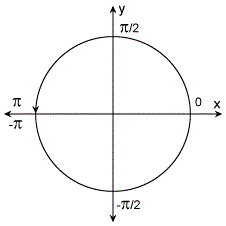atan2
Four-quadrant inverse tangent
Syntax
Description
P = atan2( returns the
four-quadrant inverse
tangent (tan-1) of Y,X)Y and
X, which must be real. The atan2
function follows the convention that atan2(x,x) returns
0 when x is mathematically zero (either
0 or -0).
Examples
Find Four-Quadrant Inverse Tangent of a Point
Find the four-quadrant inverse tangent of the point y = 4, x = -3.
atan2(4,-3)
ans = 2.2143
Convert Complex Number to Polar Coordinates
Convert 4 + 3i into polar coordinates.
z = 4 + 3i; r = abs(z)
r = 5
theta = atan2(imag(z),real(z))
theta = 0.6435
The radius r and the angle theta are the polar coordinate representation of 4 + 3i.
Alternatively, use angle to calculate theta.
theta = angle(z)
theta = 0.6435
Convert r and theta back into the original complex number.
z = r*exp(i*theta)
z = 4.0000 + 3.0000i
Plot Four-Quadrant Inverse Tangent
Plot atan2(Y,X) for -4<Y<4 and -4<X<4.
Define the interval to plot over.
[X,Y] = meshgrid(-4:0.1:4,-4:0.1:4);
Find atan2(Y,X) over the interval.
P = atan2(Y,X);
Use surf to generate a surface plot of the function. Note that plot plots the discontinuity that exists at Y=0 for all X<0.
surf(X,Y,P); view(45,45);

Input Arguments
Y — y-coordinates
scalar | vector | matrix | multidimensional array
y-coordinates, specified as a scalar, vector,
matrix, or multidimensional array. Inputs Y and X must
either be the same size or have sizes that are compatible (for example, Y is
an M-by-N matrix and X is
a scalar or 1-by-N row vector).
For more information, see Compatible Array Sizes for Basic Operations.
Data Types: single | double
X — x-coordinates
scalar | vector | matrix | multidimensional array
x-coordinates, specified as a scalar, vector,
matrix, or multidimensional array. Inputs Y and X must
either be the same size or have sizes that are compatible (for example, Y is
an M-by-N matrix and X is
a scalar or 1-by-N row vector).
For more information, see Compatible Array Sizes for Basic Operations.
Data Types: single | double
More About
Four-Quadrant Inverse Tangent
IEEE Compliance
For real inputs, atan2 has a few behaviors
that differ from those recommended in the IEEE®-754 Standard.
| MATLAB® | IEEE | |
|---|---|---|
atan2(0,-0) |
|
|
atan2(-0,-0) |
|
|
Extended Capabilities
Tall Arrays
Calculate with arrays that have more rows than fit in memory.
This function fully supports tall arrays. For more information, see Tall Arrays.
C/C++ Code Generation
Generate C and C++ code using MATLAB® Coder™.
Usage notes and limitations:
If you use
atan2with single type and double type operands, the generated code might not produce the same result as MATLAB. See Binary Element-Wise Operations with Single and Double Operands (MATLAB Coder).
GPU Code Generation
Generate CUDA® code for NVIDIA® GPUs using GPU Coder™.
GPU Arrays
Accelerate code by running on a graphics processing unit (GPU) using Parallel Computing Toolbox™.
This function fully supports GPU arrays. For more information, see Run MATLAB Functions on a GPU (Parallel Computing Toolbox).
Distributed Arrays
Partition large arrays across the combined memory of your cluster using Parallel Computing Toolbox™.
This function fully supports distributed arrays. For more information, see Run MATLAB Functions with Distributed Arrays (Parallel Computing Toolbox).
Open Example
You have a modified version of this example. Do you want to open this example with your edits?
